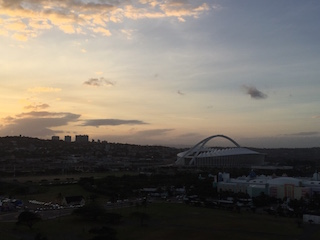Week Four: Exploring South Africa
Work this week progressed much like the last. I have continued to do research on amnesty hearings and have worked on creating a survey for our Community Buying Clubs’ project. As this week was short due to a holiday, and there is not much more to report, I have decided to dedicate this blog to some of my experiences outside of work.



Our next stop of the road trip was Durban. Durban is a popular tourist destination in South Africa because of its beautiful beaches and warm climate, which we enjoyed after a cold and rainy week in Joburg. We took a tour to learn more about the city itself while also seeing some important landmarks. Afterwards, we walked the Golden Mile, the famous beachfront strip of Durban, down to the uShaka Marine World. We also went to the top of the Moses Mabhida Stadium (developed for the 2010 World Cup) where we had a panoramic view of the city.

One of my first weekends here I visited the Apartheid museum. Touring the Apartheid Museum was both a fascinating and emotional experience. The museum takes you on a journey through different exhibits which recount the story of the apartheid. From its implementation in the 1940’s, to its ultimate end in 1994, the apartheid system horribly disadvantaged the black majority. More than 3.5 million non-white South Africans were removed from their homes and forced into segregated neighborhoods making this one of the largest mass removals in modern history. The museum walked visitors through the struggle of the black majority in its attempts to end this racist system. Given that much of my work relates to the atrocities committed during this era, it was an extremely eye-opening experience.

I also had the opportunity to visit Soweto, one of South Africa’s townships. Soweto is best known for the uprising of 1976 when police opened fire on a group of 10,000 students who were marching in protest. This marked a major turning point in the apartheid struggle as it garnered support not only from around the country, but from the international community who imposed sanctions on the South African government. The journey through the city was quite eye opening as well as it was filled with informal settlements, demonstrating some of the vast levels of poverty that exist in this country.
5. City Tour: Johannesburg
Wanting to learn more about the city of Johannesburg, I decided to take a city tour. Ironically, one of the first stops on the tour was in the mining district, only one block away from where I work! I guess that means I’m in a good location. Still, I immediately began to doubt whether spending money on tour was worth it if I was going to be shown areas I walk through every day on my way to Khulumani. But those fears were quashed as the tour took us to numerous locations around the city, about which I knew nothing.
Most notably, the tour took us to Constitution Hill, an old prison that was chosen as the site for the new Constitutional Court in the mid 1990s. In addition, we saw the Carlton Center, better known as the “Top of Africa” because it is the tallest building on the continent. In the end I am very glad to have taken the tour as it was a great opportunity to see and learn more about the wonderful city of Joburg.